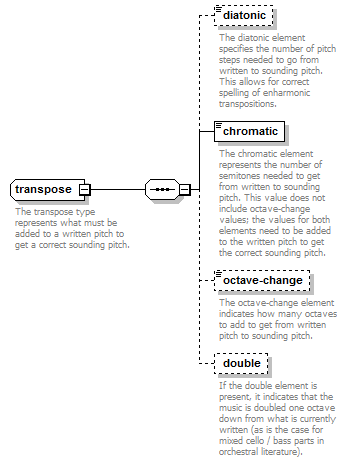<xs:complexType name="transpose">
<xs:annotation>
<xs:documentation>The transpose type represents what must be added to a written pitch to get a correct sounding pitch.</xs:documentation>
</xs:annotation>
<xs:sequence>
<xs:element name="diatonic" type="xs:integer" minOccurs="0">
<xs:annotation>
<xs:documentation>The diatonic element specifies the number of pitch steps needed to go from written to sounding pitch. This allows for correct spelling of enharmonic transpositions.</xs:documentation>
</xs:annotation>
</xs:element>
<xs:element name="chromatic" type="semitones">
<xs:annotation>
<xs:documentation>The chromatic element represents the number of semitones needed to get from written to sounding pitch. This value does not include octave-change values; the values for both elements need to be added to the written pitch to get the correct sounding pitch.</xs:documentation>
</xs:annotation>
</xs:element>
<xs:element name="octave-change" type="xs:integer" minOccurs="0">
<xs:annotation>
<xs:documentation>The octave-change element indicates how many octaves to add to get from written pitch to sounding pitch.</xs:documentation>
</xs:annotation>
</xs:element>
<xs:element name="double" type="empty" minOccurs="0">
<xs:annotation>
<xs:documentation>If the double element is present, it indicates that the music is doubled one octave down from what is currently written (as is the case for mixed cello / bass parts in orchestral literature).</xs:documentation>
</xs:annotation>
</xs:element>
</xs:sequence>
</xs:complexType> |
